Pablo el Veneciano
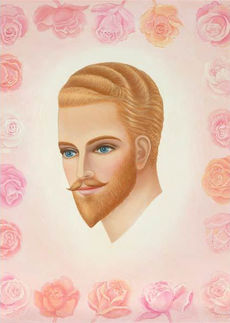
Pablo el Veneciano es el chohán del tercer rayo del amor divino. Es el jerarca del Château de Liberté, su retiro, que se encuentra en el plano etérico sobre el sur de Francia, a orillas del río Ródano.
Pablo patrocina la cultura de los maestros ascendidos para esta era y trabaja con todos aquellos que deseen producir esa cultura para la humanidad. La cultura de los maestros ascendidos supone la piedra angular de la pirámide de la era de oro; porque ellos han dicho que a través de esa cultura la humanidad responderá a las verdades espirituales y a las enseñanzas de la Gran Hermandad Blanca.
Embodiments
Head of cultural affairs on Atlantis
En los tiempos de la Atlántida Pablo prestó servicio en el Gobierno como director de los asuntos culturales. Antes de que se hundiera el continente, estableció un foco de la llama de la libertad en Perú, lo cual dio ímpetu a la cultura, belleza y riqueza de la civilización inca. Encarnó en el imperio inca como un artista que utilizó unas pinturas que no perdían el color (una maestría que volvió a demostrar en su última encarnación). Gracias al enorme impulso acumulado que produjo, la civilización inca floreció.
Artist in the Incan civilization
He embodied in the Incan empire as an artist who used paints that did not fade (a mastery that he brought back in his final embodiment). Thanks to the tremendous momentum that he drew forth, the Inca civilization flourished.
Master of architecture in Egypt
Después, Pablo encarnó en Egipto como maestro de arquitectura esotérica y trabajó de cerca con El Morya, entonces un maestro de cantería, en la época de la construcción de las pirámides.
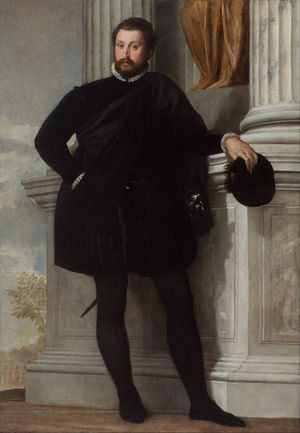
Pablo Veronés
► Artículo principal: Pablo Veronés
Su última encarnación fue la de Pablo Veronés, uno de los principales artistas de la escuela veneciana del siglo XVI. Nacido en Verona (Italia) como Paolo Cagliari en 1528, obtuvo renombre de joven como pintor talentoso gracias a su preparación inicial como artista. A la edad de veinticinco años fue recibido en Venecia como maestro de su arte. El esplendor palaciego de esta ciudad, sus perlas y sedas de Oriente, sus elegantes tapices y brocados, enriquecieron su obra, que se elevó a las alturas de la excelencia decorativa.
Las ornamentaciones de Veronés pronto lo llevaron a realizar dramáticos experimentos con colores nuevos. En su búsqueda de la belleza, se liberó de los apagados marrones y grises de sus predecesores, modelando con plena luz, haciendo que sus ya elegantes figuras fueran iridiscentes y casi transparentes. Desarrolló brillantes colores pastel azul celeste, coral, perla, lila y amarillo limón que fascinaron a sus clientes. Le encantaban los colores contrastantes intensos y vivos, y combinó tonos que jamás se habían usado anteriormente: rubí y un verde intenso aterciopelado, rosa y esmeralda, aguamarina y violeta.
Como queriendo destacar que la verdadera belleza dura para siempre, Veronés buscó y descubrió una técnica de preparación de pigmentos que no tiene igual a la hora de conservar la pintura. Sus magníficos colores aún brillan intensamente hoy día cuando se los compara con los techos apagados de la Capilla Sixtina e incluso los frescos de Tiepolo, en estado de deterioro, pintados dos siglos después.
Veronés fue un revolucionario espiritual que libró batalla contra las fuerzas opuestas a la vida en las artes. Consideraba la belleza como el más poderoso catalizador para la iluminación, y dotó a las figuras de Jesús, los apóstoles y los santos con expresiones realistas. Al asociarlos con lugares y cosas de fácil identificación, los puso al alcance de la gente corriente. El maestro trascendió los tradicionales aspectos planos, lúgubres y sin vida del arte medieval. Sus escenas bíblicas y temas históricos, festivales y desfiles estaban ejecutados con alegría y grandiosidad arrolladora.
Ilustró los pasos de la iniciación en el sendero de la Cristeidad y fue prolífico pintando el martirio de los santos. Su obra más impresionante es la enorme pintura Bodas de Caná, que se encuentra en el Louvre. Entre sus otras pinturas están La tentación de San Antonio, Coronación de la Virgen, Deposición de la cruz, Cena en Emaús, La Sagrada Familia y Resurrección de Lázaro, representando cada una de ellas una importante iniciación en la Cristeidad.
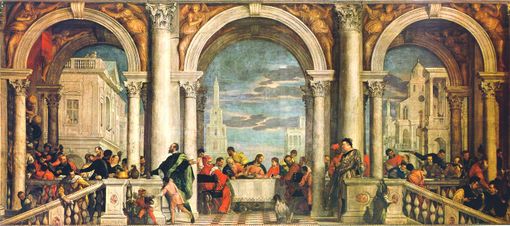
En una ocasión fue convocado ante el tribunal de la Inquisición bajo sospecha de herejía por las «irreverencias» en su cuadro La Última Cena, que tenía un enano, un loro, guardias con armaduras alemanas, perros y un bufón. Veronés defendió firmemente el derecho del artista a su libertad de imaginación. El tribunal halló una solución sugiriendo que se le cambiara el nombre a la pintura por Fiesta en la casa de Leví.
En 1588 Pablo contrajo fiebre y, tras estar enfermo unos días, murió el 9 de abril. Su hermano y sus hijos lo mandaron enterrar en San Sebastiano, donde se colocó un busto sobre su tumba. Realizó la ascensión desde el Château de Liberté el 19 de abril de 1588.
Allí, en el Château, ya había comenzado, antes de ascender, la más majestuosa de sus obras, conocida como «La Santa Trinidad». El Padre celestial está representado como una majestuosa figura, la imagen de Jesús representa el Hijo, y una impresionante paloma blanca, con una envergadura de nueve pies denota el Espíritu Santo. El lienzo posee una distinción sin precedentes al transmitir las vibraciones de las dos dimensiones de actividad, la terrenal y la celestial, en las que Pablo estaba tan interesado, pues el lienzo se terminó después de su ascensión. Debajo de la pintura «La Santa Trinidad» Pablo ha inscrito con letras doradas: «El perfecto amor echa fuera el temor».
Su misión de hoy
Pablo el Veneciano es un ser majestuoso de unos seis pies y cinco pulgadas de estatura. Es de bello semblante, con ojos azules intensos y el cabello dorado y ondulado. Va normalmente ataviado de terciopelo verde esmeralda. Al ser nativo del planeta Venus|Venus, donde los habitantes son maestros de la Llama y, por tanto, irradian armonía y amor divino, la natural herencia de Pablo es belleza y elegancia, diplomacia y tacto. Su voz es melodiosa y amable, llevando consuelo y paz a todos quienes entran en contacto con su Presencia.
El maestro ascendido Pablo el Veneciano es un gran instructor del sendero del amor. Siente devoción por la belleza, la perfección del alma mediante la compasión, la paciencia, la comprensión, la autodisciplina y el desarrollo de las facultades intuitivas y creativas del corazón mediante la alquimia del sacrificio, la abnegación y la renuncia. Inicia el chakra del corazón y nos prepara en lo relativo al don del discernimiento de espíritus, el discernir del bien y el mal, la luz y la sombra y los delicados matices de todas nuestras creaciones hermosas. El discernimiento es una verdadera sensibilidad interior de unos hacia otros.
Retiros
► Artículo principal: Château de Liberté
► Artículo principal: Templo del Sol
El retiro de Pablo, el Château de Liberté, tiene un equivalente físico en un castillo actualmente propiedad de una familia francesa. En el nivel etérico, el retiro contiene aulas con pinturas y obras de arte de todas las clases y de todas las épocas, razas y culturas, así como talleres para músicos, escritores, escultores y estudiantes de canto. Allí los maestros presentan nuevas técnicas en todos los campos del arte.
Actualmente Pablo el Veneciano da clases en el Templo del Sol, el retiro etérico sobre Manhattan de la Diosa de la Libertad, que es la Madre espiritual de Pablo y el ser cósmico que hay detrás de la Estatua de la Libertad y que lleva ese nombre debido a su completa identificación con la conciencia Divina de la libertad. Ella fue quien por primera vez consagró la llama de la libertad en la Tierra y, justo antes del hundimiento de la Atlántida, la transportó desde su entonces físico Templo del Sol al Château de Liberté.
Transfer of the Liberty Flame from his retreat
Fue la Diosa de la Libertad quien inspiró la idea de la Estatua de la Libertad como regalo del pueblo de Francia al de los Estados Unidos, que fue dedicado en la Isla de Bedloe el 28 de octubre de 1886. Como símbolo de su amistad y más, supuso la extensión del arco de la libertad desde Château de Liberté hasta el Templo del Sol, con la finalidad de que los descendientes de la Atlántida reencarnados en sus puertas de Oriente y de Occidente (en Francia y en los Estados Unidos) sostuvieran en alto su antorcha hasta que la cultura de la Libertad volviera a aparecer en una era de oro fundada sobre la llama trina equilibrada y expandida en el del pueblo amante de la libertad de estas naciones hermanas.
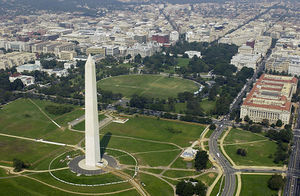
Setenta y seis años después, en un dictado dado en la Ciudad de Washington el 30 de septiembre de 1962, el maestro ascendido K-17 anunció el otorgamiento de otro regalo de Francia a América, esta vez por parte de Pablo el Veneciano:
Ha tenido lugar una sesión hermosa y maravillosa en el retiro de Chananda, en la India, y el amado Pablo el Veneciano ha tomado una decisión, por la cual hoy se ha transferido desde su retiro, en Francia, a las once, hora vuestra, el pleno latido de la llama de la libertad.
Esta llama se colocó permanentemente dentro del campo energético del Monumento a Washington; y los latidos de la llama de la libertad quieren adornar el corazón de América como un regalo de la Hermandad y del corazón del amado Pablo el Veneciano…
It is given as a treasure from the heart of France, from the spiritual government of France to the spiritual government of America.... The liberty flame is a gift of greater magnitude than the former gift of France, the Statue of Liberty, as a tribute to that great being, the Goddess of Liberty. It is incomparable, for the flame itself shall penetrate the structure of the monument, rising high into the atmosphere above it. And all who visit there shall become, even without knowing it, infused by the pulsations of the liberty flame within the heart of America.
Studying with Paul the Venetian
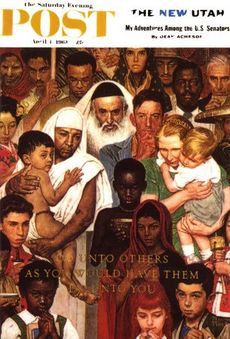
Embodied mankind who serve in the arts attend the retreats of Paul the Venetian for instruction in all of the arts, and through their service, they learn to balance and expand the threefold flame within the heart. Paul explains that the purpose of art is to enhance the love of Christ always.
One who studied at Paul the Venetian’s retreat was Norman Rockwell, American painter and illustrator (1894–1978). Paul speaks of instructing him:
I remember when Norman Rockwell came to me at inner levels to study in my etheric retreat. And I remember as I counseled him to show the Christ in the American people, in everyday scenes of humor, humility, wonder, togetherness, heroism. And all these have been treasured, remembered and valued highly because something of the spirit of the Christ image that is become an image of America came through his work.
A unique artist, one devoted to the inherent qualities and identity of the individual. As his perception of the Christ was, so was his painting the capturing of unique moments. You might examine that work to find in each painting what is the glimmer, however great or faint, of some aspect of the individual reaching for the Higher Self.[1]
The beloved master Paul has promised an important initiation to those who come knocking at the door of his retreat in southern France, ready for a greater increment of the love flame:
I will take you by the hand and show you my castle. I will show you the works of art that have been brought forth by chelas unascended and ascended. And we will go through many rooms, and lastly I will take you to the room where there is that frame that hangs. In some cases it will be an empty frame; in some cases it will have a canvas in it. It will be your frame, the frame of your identity waiting for you to bring forth the genius of your soul. And when you see that frame, if it is empty, you will want to fill it.
And so I will take you to that place, “The Atelier,” where you can work with other artisans who are learning the art of living love by the discipline of the hand and the discipline of expression so that you can draw the image of your own Christ-perfection. And when it is the best that you have to offer, it will be placed in your frame.
And when you come again before that frame after many months of purging and self-purification, you will say undoubtedly, “Beloved Paul, may I have another opportunity to express my Christhood, to draw the image of myself? For I have perceived a new aspect of that image, and I would like to have this, my best offering, now placed in my frame.” And, of course, you will have the opportunity.”[2]
The purpose of art
The ascended master Paul the Venetian says:
I AM Paul the Venetian. I paint on canvas on the ethers. I etch in crystal, I sculpt, I mold the clay. I fashion all things physical and many substances not known to you in the higher octaves. To what purpose? To the purpose of showing forth an evermore revealing and exquisite image of the Christ—the Christ appearing in children, in people from every walk of life....
Is it any wonder that we deplore the chaotic and abstract art that has no point of unity? It also portrays a certain barrenness and absence of that point of light in the individual. One can see anarchy by an absence of dimension—an absence of harmony or focalization in modern art.
Modern art enters the subconscious. Accordingly, whether or not the artist is influenced by marijuana or other substances, art portrayed in fabric design, wall coverings, clothing style becomes a matrix capable or incapable of carrying some measure of Christly proportion. When the peoples’ art and sense of art flounders, then the images of Christ recede.
It is rare to find a work of art that is come from the etheric octave in this period.... Where will your leaders learn to deal with the invaders of the minds of the nations? They will learn from the etheric schoolrooms and cities and retreats. How will they get there if they do not contain the crystal that becomes the magnet and a star to follow when the soul goes forth from the body in the hours of sleep?
Unless angels and devotees of light accompany them, they will have no new idea, no means of resolution. Without internal harmony that is the direct child of perfect love, there is no resolution to international terror or the threat of nuclear war. And while abortion itself seems to me the supreme act of anti-art, it does beget the callousness that year-by-year has a lessening sensitivity to the art of angels and the art of God who fashioned the perfect image out of which you were sculpted in clay.
Thus, beloved ones, it is necessary in the very midst of the most tense international circumstances to retreat into the contemplation of the divine beauty and the music of the spheres, to remember that the building blocks of creation are sound and that sound forms a pattern that is a divine harmony and that this divine harmony can be portrayed in architecture, in life, in everyday utensils such as pottery. The things you use and you surround yourself with become a focus for the flow of attention.
Art is not a subject so often dwelt upon in our discourses, for there are such pressing needs—pressing needs of the hour for the victory for Saint Germain. I bring my ingredient of love in this hour as an offering to the Christ Child, to the one and the beloved whom I have so longed to paint in the ultimate sense and have done so to the best of my ability in the etheric octave.[3]
His twin flame
Paul the Venetian’s twin flame is the ascended lady master Ruth Hawkins, the Goddess of Beauty. She ascended in 1995 at the age of eighty-eight and serves with him at the Temple of the Sun.
You may pray to Paul the Venetian to assist you in developing your heart chakra and the threefold flame of the heart and to bring forth the image of the Christ consciousness in your life. Ask him to sponsor the true art of the Aquarian age and to overshadow artists of all kinds in bringing forth the consciousness of the Christ.
Paul the Venetian’s keynote is “I Love You Truly,” by Carrie Jacobs-Bond.
See also
For more information
For more information about the teachings of Paul the Venetian, see the chapters about him in Mark L. Prophet and Elizabeth Clare Prophet, Lords of the Seven Rays.
Sources
Mark L. Prophet and Elizabeth Clare Prophet, The Masters and Their Retreats, s.v. “Paul the Venetian.”
- ↑ Paul the Venetian, “The Art of Love,” Pearls of Wisdom, vol. 27, no. 3, January 15, 1984.
- ↑ Mark L. Prophet and Elizabeth Clare Prophet, Lords of the Seven Rays, book 2, pp. 112–13.
- ↑ Paul the Venetian, “The Art of Love,” Pearls of Wisdom, vol. 27, no. 3, January 15, 1984.
